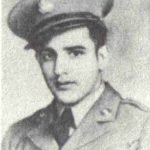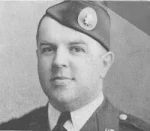Capt. Roy Swangren was born in Oak Park, Illinois, on August 16, 1920, to Thure J. Swangren and Marie Ziehnert-Swangren and had a sister and a brother. His family resided at 614 South 6th Avenue, Maywood, Illinois. He graduated from Emerson School and Proviso Township High School in 1938. After high school, he worked as a mechanic at S&S Machine Works, Chicago.
On February 16, 1942, he registered with Selective Service and named his father as his contact person. He enlisted in the US Army on March 25, 1942, and was issued the serial number 16 077 126. Since he had scored higher than 110 on the Army General Classification test, he was allowed to volunteer for the Army Air Corps and pilot training.
Although he trained at multiple bases, but the only two bases that he is known to have trained are Kelly Field, San Antonio, Texas, and Hondo Field, Hondo, Texas, where he was commissioned a second lieutenant and issued the serial number O 676 167. He also qualified as a navigator. He was assigned to the 579th Bomb Squadron, 392nd Bombardment Group (Heavy), 8th Air Force, which flew B-24s. His unit arrived in England and was stationed at Wendling Station #118, Norfolk, England.
Roy flew his first mission – which was a diversion mission – on September 23, 1943 and his second mission was also a diversion mission on the 27th. On October 2nd, his plane, which was designated A/C 561, took part in a bombing mission against an German airfield in Holland but because of cloud cover did not drop their bombs because of a policy not to bomb an occupied country if the target was covered by clouds.
Roy would take part in in the mission of February 24, 1944, on Gotha, Germany, where the Germans had an aircraft plant and manufactured components during what was considered a Big Week for missions against German military targets. Thirty-six planes took part in the mission. During the mission the 392nd lost six planes to enemy fire and fighters. It has been stated that this may have been one of the most important bombing missions of the war and successfully destroyed the main production lines for manufacturing planes.
Roy took part in various missions against targets in France, Belgium, Holland, and Germany. At some point , he was promoted to captain, in June 1944, and made the squadron’s navigator. On March 22, 1945, Roy was took part in a bombing mission against the Schwabisch Hall. The target was a German jet airfield. The mission was a success and the bombers experienced little enemy flak and no German fighters intercepted them. As the planes landed at Wendling, a flare gun was said to have come loose, fell to the floor, discharged, and set off a box of pyrotechnic flares located behind the pilot’s seat. The resulting fire blinded the pilot and co-pilot which resulted in the plane going into a steep dive. Three of the crew members managed to bail out of the plane. The remaining men, including Roy, died when the plane crashed into the ground one and a quarter miles north of Coltishall, Norfolk County, England. The bodies of these men were found in the wreckage. Roy had a compound fracture to his skull and various other fractures.
A telegram was sent to his father about Roy’s death, but its content is not known. On March 27, 1945, Roy was buried in the Cambridge American Cemetery in Plot V, Row 9, Grave 23, and his grave was marked with a wooden cross. One of his government issued identification tags was attached to the cross and the other was buried with him.
His father next heard from the Office of the Quartermaster General, dated February 11, 1946, telling him where was buried and the location of his grave in the cemetery. Another letter, dated February 4, 1947, told his father about the cemetery and that at some point in the future he would be provided information on his options for Roy’s final burial. The next letter, dated March 26, 1947, provided his father on his options for Roy’s final burial. He was asked to complete an enclosed form and return it to the Office of the Quartermaster General, Washington DC. The form was returned but was not properly completed. It took until May 5, 1948, to get the form completed. His father indicated that Roy should be buried at an American Military Cemetery, Overseas.
Since the Cambridge American Cemetery was designated a permanent cemetery, Roy remained buried in the cemetery, although it appears his casket was moved to another grave. After this was done, his father received the flag that covered Roy’s casket and a letter from the Quartermaster General.
Capt Roy Swangren, ASN O 676 167
Plot F, Row 1, Grave 125
Headstone: Cross
Cambridge (England) U. S. Military Cemetery
Mr. T. Joseph Swangren
614 South 6th Avenue
Maywood, Illinois
Dear Mr. Swangren:
This is to inform you that the remains of your beloved one have been permanently interred, as the recorded above, side by side with comrades who also gave their lives for their country. Customary military funeral services were conducted over the grave at the time of burial.
After the Department of the Army has completed all final interments, the cemetery will be transferred, as authorized by the Congress, to the care and supervision of the American Battle Monuments Commission. The commission will have the responsibility for permanent construction and beautification of the cemetery, including erection of the permanent headstone. The headstone will be inscribe with the name exactly recorded above, the rank or rating where appropriate, organization, State, and date of death. Any inquiries relative to the type of headstone or the spelling of the name to be inscribed thereon, should be addressed to the American Battle Monuments Commission, the central address of which is 1712 “G” Street, N. W. Washington 25, D. C. Your letter should include the full name, rank, serial number, grave location, and name of the cemetery.
While interments and beautification activities are in progress, the cemetery will not be open to visitors. You may be rest assured that this final interment was conducted with fitting dignity and solemnity and that the grave-site will be care-fully and conscientiously maintained in perpetuity by the United States Government.
Sincerely yours,
(signed)
W. FELDMAN
Major General
The Quartermaster General







